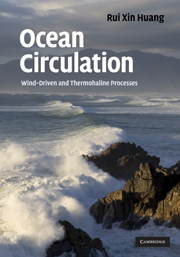4 - Wind-driven circulation
from Part II - Wind-driven and thermohaline circulation
Published online by Cambridge University Press: 05 June 2012
Summary
Simple layered models
Pressure gradient and continuity equations in layered models
The concept of layered models
The simplest way to simulate the ocean circulation is to assume that the ocean is homogeneous in density. Such a model has no vertical structure. As discussed in Section 1.4, there is a prominent main thermocline/pycnocline in the oceans. The subsurface maximum of the vertical density gradient can be idealized as a step function, and a natural way of simulating the ocean circulation is to treat the ocean as a two-layer fluid, using the main thermocline as the interface. The lower layer lies below the main thermocline; it is very thick and water in this layer moves much slower than that above the main thermocline. As a good approximation, one can assume that fluid in the lower layer is nearly stagnant. Such a model has one active layer only; this is called a reduced-gravity model. The advantage of a reduced-gravity model is its ability to capture the first baroclinic mode of the circulation and the depth of the main thermocline. Adding one more layer to the standard reducedgravity model, one obtains a 2½-layer model, which is also discussed in this chapter. The comparison of these models is outlined in Figure 4.1.
In a sense, a reduced-gravity model is equivalent to using just two grids in the density coordinate. Similarly, multi-layer models are highly truncated models in the density coordinate.
Information
- Type
- Chapter
- Information
- Ocean CirculationWind-Driven and Thermohaline Processes, pp. 261 - 479Publisher: Cambridge University PressPrint publication year: 2009
Accessibility standard: Unknown
Why this information is here
This section outlines the accessibility features of this content - including support for screen readers, full keyboard navigation and high-contrast display options. This may not be relevant for you.Accessibility Information
- 1
- Cited by
